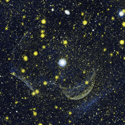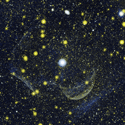Cosmic backtracking
Exploding stars called novae are thermonuclear outbursts triggered when a white dwarf star gravitationally captures hydrogen-rich material from a nearby companion star. A number of meteoritic grains from the early solar system have been discovered that may have been produced in novae. If so, the ratios between different isotopes of silicon in these grains may reflect conditions during the nova outburst. In order to predict the isotopic ratios expected in these grains and compare with the observed values, it is critical to understand the nuclear reactions that lead to silicon nucleosynthesis.
Writing in Physical Review C, Kiana Setoodehnia and colleagues at McMaster University in Canada, and collaborators in Germany and the US, have examined the reaction, which affects the synthesis of silicon in novae. (Both and are unstable and decay to silicon isotopes.)
By accurately measuring the energies of excited states in , Setoodehnia et al. have been able to calculate the rate of the reaction with improved precision and find that it is significantly higher (by about a factor of for certain temperatures) than previously thought. A new excited state—seen here for the first time—makes a significant contribution to the reaction rate near the temperatures that occur during a nova outburst.
The impact of Setoodehnia et al.’s results on predicting silicon isotopic ratios in models of novae will likely be significant, and will be explored in future work. – Brad Filippone





